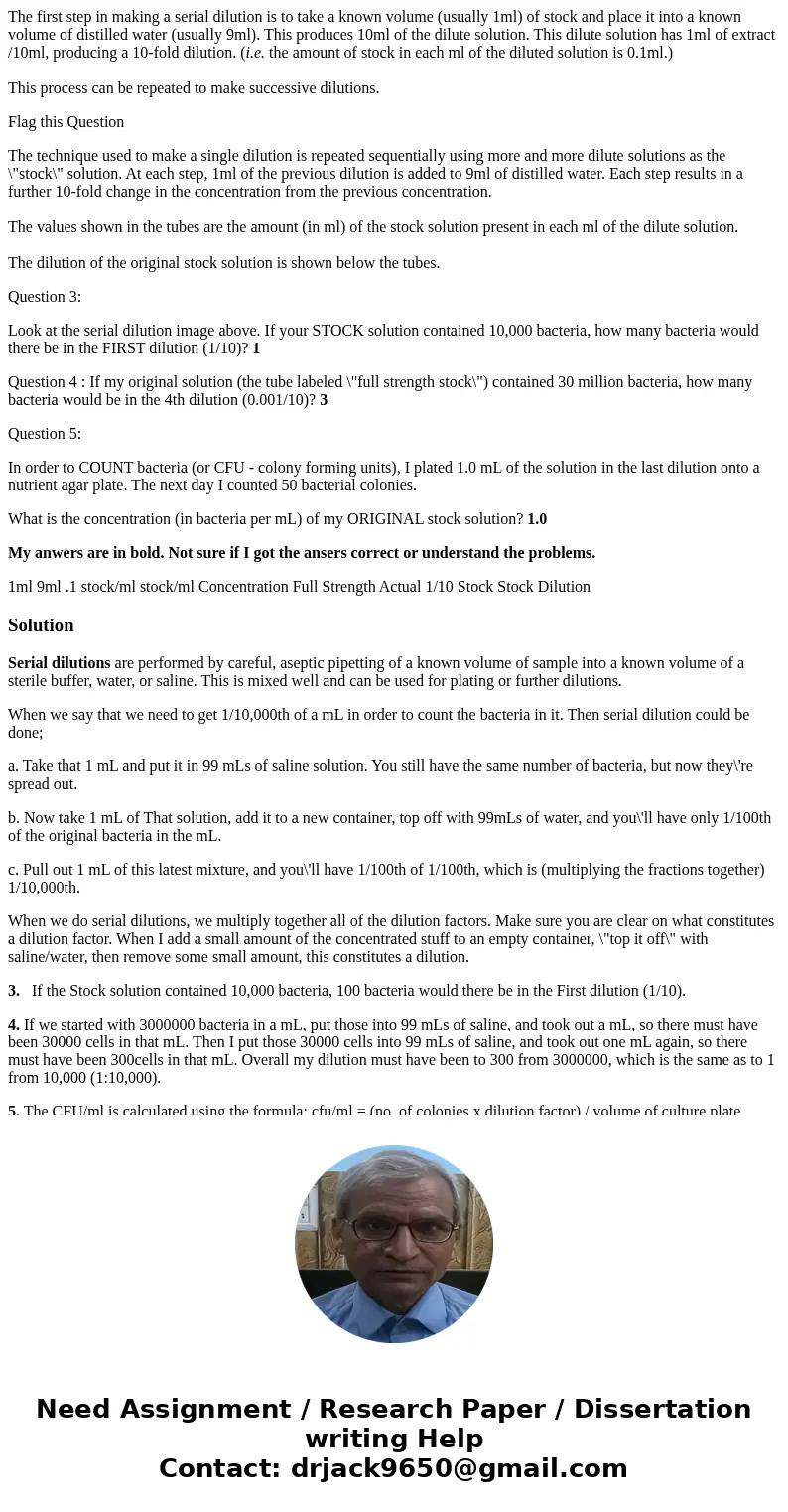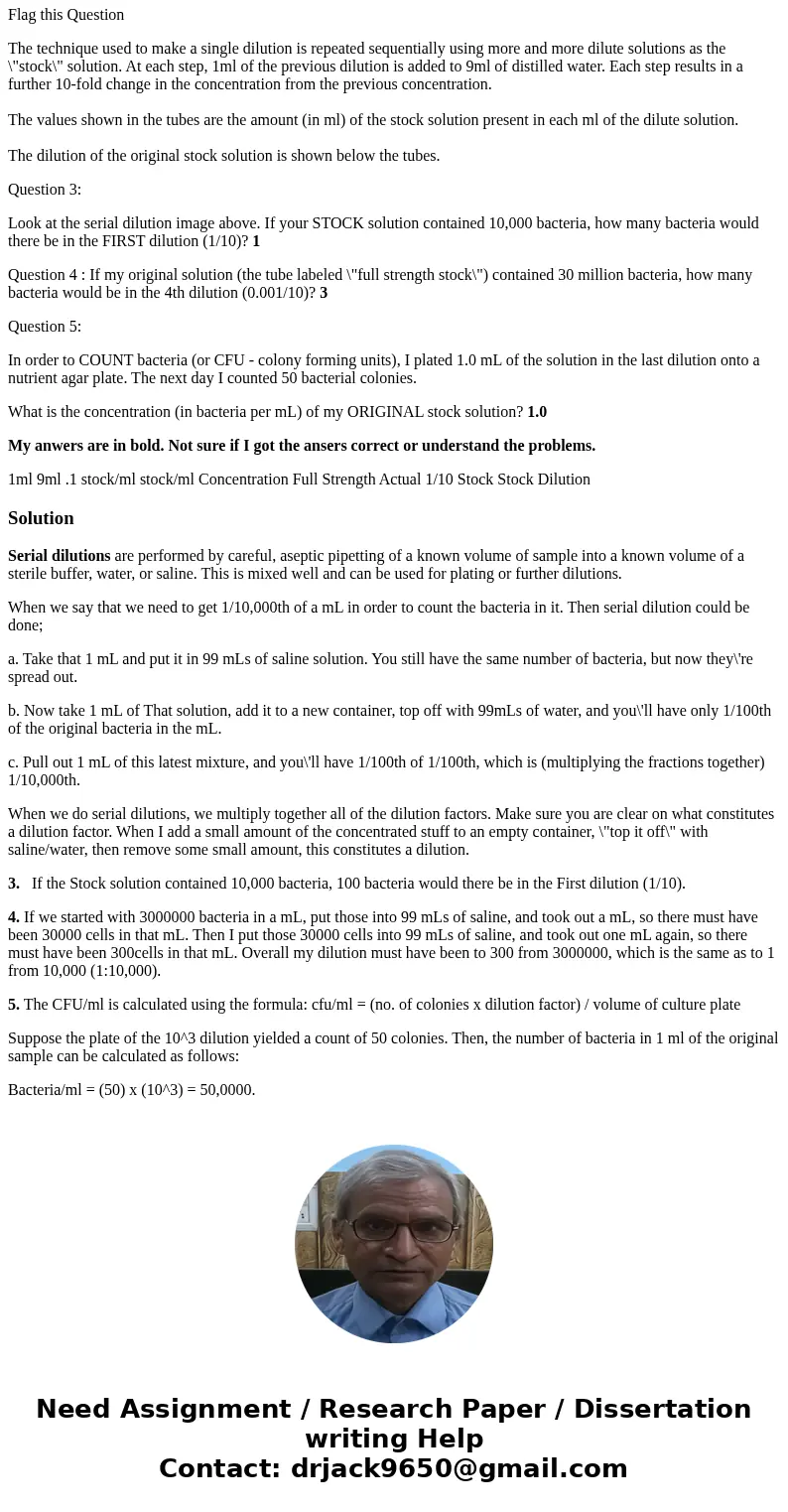The first step in making a serial dilution is to take a know
The first step in making a serial dilution is to take a known volume (usually 1ml) of stock and place it into a known volume of distilled water (usually 9ml). This produces 10ml of the dilute solution. This dilute solution has 1ml of extract /10ml, producing a 10-fold dilution. (i.e. the amount of stock in each ml of the diluted solution is 0.1ml.)
This process can be repeated to make successive dilutions.
Flag this Question
The technique used to make a single dilution is repeated sequentially using more and more dilute solutions as the \"stock\" solution. At each step, 1ml of the previous dilution is added to 9ml of distilled water. Each step results in a further 10-fold change in the concentration from the previous concentration.
The values shown in the tubes are the amount (in ml) of the stock solution present in each ml of the dilute solution.
The dilution of the original stock solution is shown below the tubes.
Question 3:
Look at the serial dilution image above. If your STOCK solution contained 10,000 bacteria, how many bacteria would there be in the FIRST dilution (1/10)? 1
Question 4 : If my original solution (the tube labeled \"full strength stock\") contained 30 million bacteria, how many bacteria would be in the 4th dilution (0.001/10)? 3
Question 5:
In order to COUNT bacteria (or CFU - colony forming units), I plated 1.0 mL of the solution in the last dilution onto a nutrient agar plate. The next day I counted 50 bacterial colonies.
What is the concentration (in bacteria per mL) of my ORIGINAL stock solution? 1.0
My anwers are in bold. Not sure if I got the ansers correct or understand the problems.
1ml 9ml .1 stock/ml stock/ml Concentration Full Strength Actual 1/10 Stock Stock DilutionSolution
Serial dilutions are performed by careful, aseptic pipetting of a known volume of sample into a known volume of a sterile buffer, water, or saline. This is mixed well and can be used for plating or further dilutions.
When we say that we need to get 1/10,000th of a mL in order to count the bacteria in it. Then serial dilution could be done;
a. Take that 1 mL and put it in 99 mLs of saline solution. You still have the same number of bacteria, but now they\'re spread out.
b. Now take 1 mL of That solution, add it to a new container, top off with 99mLs of water, and you\'ll have only 1/100th of the original bacteria in the mL.
c. Pull out 1 mL of this latest mixture, and you\'ll have 1/100th of 1/100th, which is (multiplying the fractions together) 1/10,000th.
When we do serial dilutions, we multiply together all of the dilution factors. Make sure you are clear on what constitutes a dilution factor. When I add a small amount of the concentrated stuff to an empty container, \"top it off\" with saline/water, then remove some small amount, this constitutes a dilution.
3. If the Stock solution contained 10,000 bacteria, 100 bacteria would there be in the First dilution (1/10).
4. If we started with 3000000 bacteria in a mL, put those into 99 mLs of saline, and took out a mL, so there must have been 30000 cells in that mL. Then I put those 30000 cells into 99 mLs of saline, and took out one mL again, so there must have been 300cells in that mL. Overall my dilution must have been to 300 from 3000000, which is the same as to 1 from 10,000 (1:10,000).
5. The CFU/ml is calculated using the formula: cfu/ml = (no. of colonies x dilution factor) / volume of culture plate
Suppose the plate of the 10^3 dilution yielded a count of 50 colonies. Then, the number of bacteria in 1 ml of the original sample can be calculated as follows:
Bacteria/ml = (50) x (10^3) = 50,0000.


 Homework Sourse
Homework Sourse